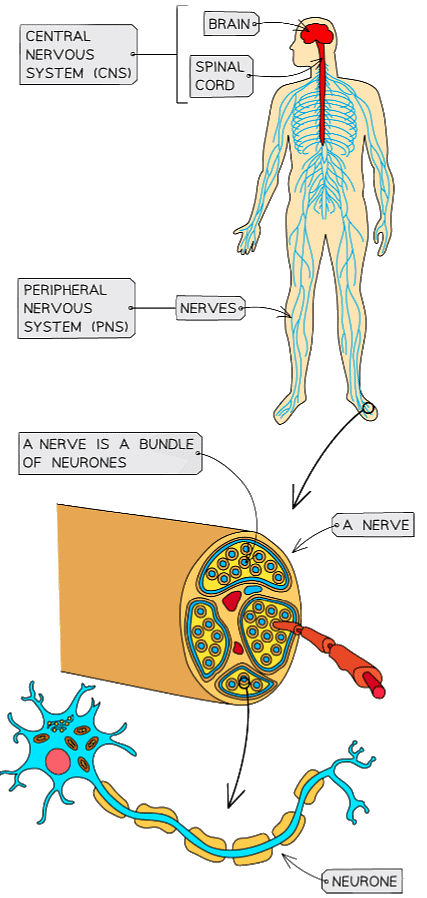Grade 10 Exam > Grade 10 Notes > Biology for Grade 10 > Homeostasis & Human Nervous System
Homeostasis & Human Nervous System | Biology for Grade 10 PDF Download
| Table of contents |

|
| Homeostasis |

|
| Nervous system |

|
| Nervous System: Basics |

|
| Adaptations of the Nervous System |

|
| Structure of the Nervous System |

|
Homeostasis
Homeostasis maintains optimal conditions for enzyme action throughout the body, as well as all cell functions.
In the human body, these include the control of:
- blood glucose concentration
- body temperature
- water levels
These automatic control systems may involve nervous responses (nervous system) or chemical responses (endocrine system).
Nervous system
The human nervous system consists of:
- the central nervous system – the brain and spinal cord
- the peripheral nervous system – nerve cells that carry information to or from the CNS

Nervous System: Basics
- The human nervous system consists of:
- Central nervous system (CNS) – the brain and spinal cord
- Peripheral nervous system (PNS) – all of the nerves in the body
- The nervous system enables humans to react to their surroundings and to coordinate their behaviour
- Information is sent through the nervous system as electrical impulses – electrical signals that pass along nerve cells known as neurones
- A bundle of neurones is known as a nerve
Adaptations of the Nervous System
- Neurones have a cell body (where the nucleus and main organelles are found) and cytoplasmic extensions from this body called axons and dendrites
- Some human neurones have axons over a metre in length (but only 1 - 4 micrometres wide)
- This is far more efficient than having multiple neurones to convey information from the CNS to effectors – less time is wasted transferring electrical impulses from one cell to another
- The axon is insulated by a fatty myelin sheath with small uninsulated sections along it (called nodes) which the impulse jumps along
 The human nervous system is comprised of the CNS and the PNS
The human nervous system is comprised of the CNS and the PNS
Structure of the Nervous System
- Information from receptors passes along cells (neurones) as electrical impulses to the central nervous system (CNS)
- The CNS is the brain and spinal cord
- The CNS coordinates the response of effectors which may be muscles contracting or glands secreting hormones
- The pathway through the nervous system is:
stimulus → receptor → coordinator → effector → response
The document Homeostasis & Human Nervous System | Biology for Grade 10 is a part of the Grade 10 Course Biology for Grade 10.
All you need of Grade 10 at this link: Grade 10
|
110 videos|93 docs|9 tests
|

|
Explore Courses for Grade 10 exam
|

|
Signup for Free!
Signup to see your scores go up within 7 days! Learn & Practice with 1000+ FREE Notes, Videos & Tests.
Related Searches


















